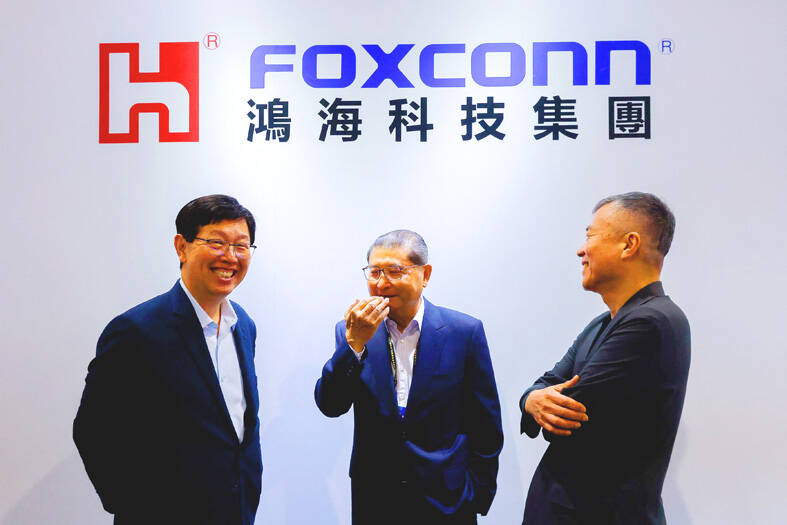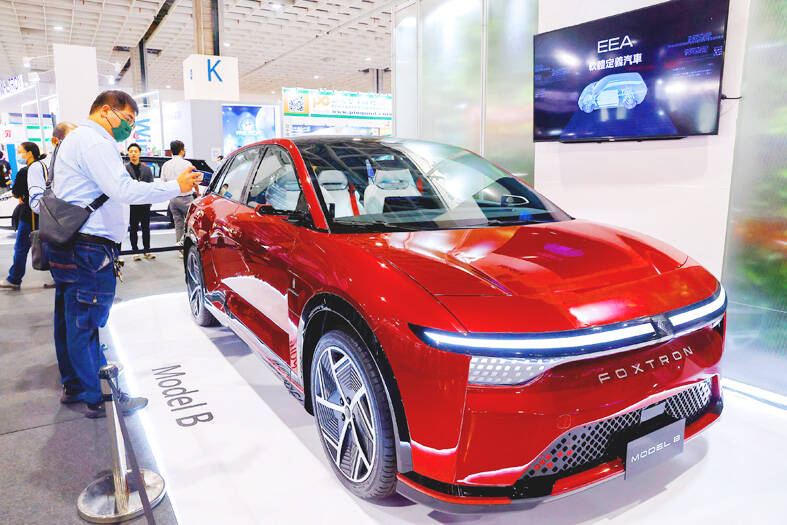The MIH Consortium, an electric vehicle (EV) alliance led by Taiwan-based manufacturing giant Hon Hai Precision Industry Co (鴻海精密), plans to introduce its first commercial electric vehicle prototype in October, it said on Wednesday.
Work on the A-segment Project X demonstration EV is progressing well, MIH CEO Jack Cheng (鄭顯聰) said in an interview at the Taipei International Automobile Electronics Show.
The three-seat EV is likely to be completed in October and begin mass production in 2025, he said.

Photo: Ann Wang, Reuters
The consortium also plans to unveil concepts for a six-seat version of the vehicle next year and a nine-seater in 2025, Cheng said.
MIH plans to focus the vehicle’s promotion on transportation and logistics companies, he said.
MIH had said earlier that the three-seat Project X vehicle would retail at under US$20,000, while buyers would be able to choose from a wide range of customization options via the MIH “build your own vehicle” model.

Photo: Ann Wang, Reuters
MIH has been working with Hon Hai and Thailand’s PTT PCL to extend the consortium’s supply chain into Thailand, where it plans to set up a technological innovation center, Cheng said.
Created to serve the MIH EV open platform, the MIH consortium became operational in July 2021 as part of Hon Hai’s efforts to enter the EV market and diversify from contract manufacturing into hardware and software capabilities.
The open platform was initiated by Hua-chuang Automobile Information Technical Center Co (華創車電), a subsidiary of Taiwan’s Yulon Motor Co (裕隆), and aims to become what executives called “the Android of the EV industry.”
The MIH alliance has 2,621 members in 69 countries and regions around the world.

Taiwan’s long-term economic competitiveness will hinge not only on national champions like Taiwan Semiconductor Manufacturing Co. (TSMC, 台積電) but also on the widespread adoption of artificial intelligence (AI) and other emerging technologies, a US-based scholar has said. At a lecture in Taipei on Tuesday, Jeffrey Ding, assistant professor of political science at the George Washington University and author of "Technology and the Rise of Great Powers," argued that historical experience shows that general-purpose technologies (GPTs) — such as electricity, computers and now AI — shape long-term economic advantages through their diffusion across the broader economy. "What really matters is not who pioneers

In a high-security Shenzhen laboratory, Chinese scientists have built what Washington has spent years trying to prevent: a prototype of a machine capable of producing the cutting-edge semiconductor chips that power artificial intelligence (AI), smartphones and weapons central to Western military dominance, Reuters has learned. Completed early this year and undergoing testing, the prototype fills nearly an entire factory floor. It was built by a team of former engineers from Dutch semiconductor giant ASML who reverse-engineered the company’s extreme ultraviolet lithography (EUV) machines, according to two people with knowledge of the project. EUV machines sit at the heart of a technological Cold

TAIWAN VALUE CHAIN: Foxtron is to fully own Luxgen following the transaction and it plans to launch a new electric model, the Foxtron Bria, in Taiwan next year Yulon Motor Co (裕隆汽車) yesterday said that its board of directors approved the disposal of its electric vehicle (EV) unit, Luxgen Motor Co (納智捷汽車), to Foxtron Vehicle Technologies Co (鴻華先進) for NT$787.6 million (US$24.98 million). Foxtron, a half-half joint venture between Yulon affiliate Hua-Chuang Automobile Information Technical Center Co (華創車電) and Hon Hai Precision Industry Co (鴻海精密), expects to wrap up the deal in the first quarter of next year. Foxtron would fully own Luxgen following the transaction, including five car distributing companies, outlets and all employees. The deal is subject to the approval of the Fair Trade Commission, Foxtron said. “Foxtron will be

INFLATION CONSIDERATION: The BOJ governor said that it would ‘keep making appropriate decisions’ and would adjust depending on the economy and prices The Bank of Japan (BOJ) yesterday raised its benchmark interest rate to the highest in 30 years and said more increases are in the pipeline if conditions allow, in a sign of growing conviction that it can attain the stable inflation target it has pursued for more than a decade. Bank of Japan Governor Kazuo Ueda’s policy board increased the rate by 0.2 percentage points to 0.75 percent, in a unanimous decision, the bank said in a statement. The central bank cited the rising likelihood of its economic outlook being realized. The rate change was expected by all 50 economists surveyed by Bloomberg. The